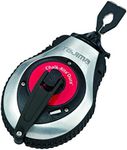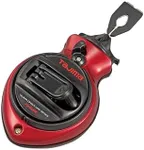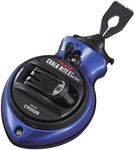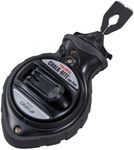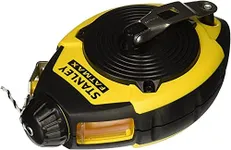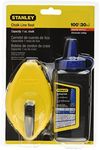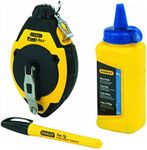Buying Guide for the Best Chalk Line Tools
Choosing the right chalk line tool can make a significant difference in the accuracy and efficiency of your projects. Chalk line tools are essential for marking straight lines on flat surfaces, which is crucial for tasks like laying tiles, framing, or any construction work that requires precision. To pick the best chalk line tool for your needs, you should consider several key specifications. Understanding these specs will help you make an informed decision and ensure that the tool you choose is the best fit for your specific requirements.Line LengthThe line length of a chalk line tool refers to the maximum distance the line can be extended. This is important because it determines how long a straight line you can mark without having to reposition the tool. Line lengths typically range from 50 feet to 100 feet or more. For small projects or indoor use, a shorter line length (around 50 feet) is usually sufficient. For larger projects, such as outdoor construction or large-scale layouts, a longer line length (75 feet or more) is more appropriate. Choose a line length based on the scale of your projects.
Chalk CapacityChalk capacity refers to the amount of chalk powder the tool can hold. This is important because it affects how often you need to refill the tool. A larger chalk capacity means fewer refills, which can save time and increase efficiency. Chalk capacities can vary, with some tools holding as little as 1 ounce and others holding up to 6 ounces or more. If you are working on large projects or using the tool frequently, a higher chalk capacity is beneficial. For occasional use or smaller projects, a lower capacity may be sufficient.
Line MaterialThe material of the line itself can impact the durability and visibility of the marks it makes. Common materials include cotton, polyester, and nylon. Cotton lines are typically less expensive but may wear out faster. Polyester and nylon lines are more durable and can withstand more tension and wear. If you need a chalk line tool for heavy-duty use or rough surfaces, opt for a polyester or nylon line. For light-duty tasks or smooth surfaces, a cotton line may be adequate.
Reel MechanismThe reel mechanism is how the line is wound back into the tool. This is important for ease of use and efficiency. There are manual reels, which require you to wind the line back by hand, and automatic reels, which use a spring mechanism to retract the line quickly. Automatic reels are more convenient and faster, making them ideal for frequent use or large projects. Manual reels are simpler and may be more durable, suitable for occasional use or smaller projects. Choose a reel mechanism based on how often and how quickly you need to retract the line.
Chalk ColorChalk color affects the visibility of the line on different surfaces. Common colors include blue, red, and white. Blue chalk is the most versatile and works well on most surfaces. Red chalk is more permanent and visible on darker surfaces, making it ideal for outdoor use or surfaces that will not be painted over. White chalk is less permanent and works well on dark surfaces indoors. Choose a chalk color based on the surface you will be marking and whether you need the line to be temporary or permanent.

